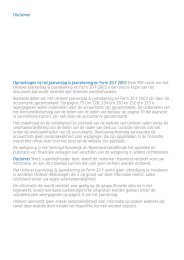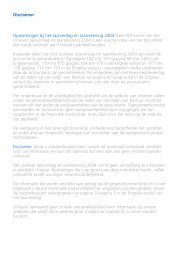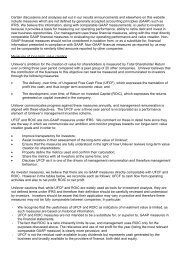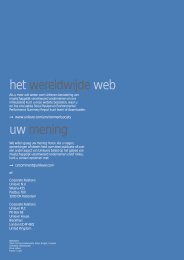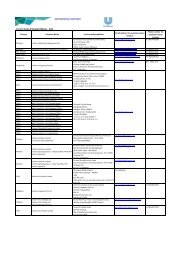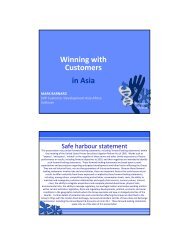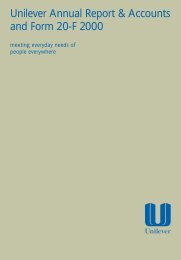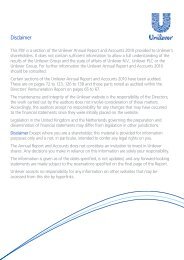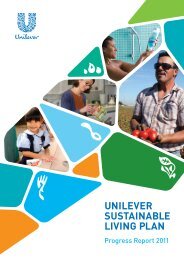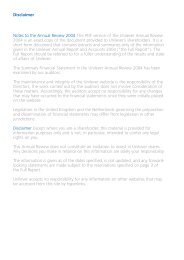Meeting everyday needs of people everywhere - Unilever
Meeting everyday needs of people everywhere - Unilever
Meeting everyday needs of people everywhere - Unilever
Create successful ePaper yourself
Turn your PDF publications into a flip-book with our unique Google optimized e-Paper software.
Differences from United States GAAP<br />
<strong>Unilever</strong> Group<br />
The consolidated accounts <strong>of</strong> the <strong>Unilever</strong> Group have been<br />
prepared in accordance with accounting principles which differ<br />
in certain respects from those generally accepted in the United<br />
States (US GAAP).<br />
The principal differences are set out below.<br />
Pr<strong>of</strong>it on sale <strong>of</strong> chemicals businesses<br />
<strong>Unilever</strong> calculates pr<strong>of</strong>it on sale <strong>of</strong> businesses after writing back<br />
any goodwill previously charged directly to reserves. Under<br />
US GAAP the pr<strong>of</strong>it on disposal <strong>of</strong> the discontinued speciality<br />
chemicals businesses is stated net <strong>of</strong> the relevant unamortised<br />
goodwill included on the balance sheet and the cumulative<br />
currency retranslation differences recognised through the<br />
statement <strong>of</strong> total recognised gains and losses.<br />
Goodwill and other intangibles<br />
Prior to 1 January 1998 <strong>Unilever</strong> wrote <strong>of</strong>f goodwill and all other<br />
intangible assets arising on the acquisition <strong>of</strong> new interests in<br />
group companies and joint ventures directly to pr<strong>of</strong>it retained in<br />
the year <strong>of</strong> acquisition. Under US GAAP goodwill and identifiable<br />
intangibles, principally trade marks, are capitalised and amortised<br />
against income over their estimated useful lives, not exceeding<br />
40 years.<br />
There is no difference between the accounting policy applied to<br />
goodwill and intangible assets purchased after 1 January 1998<br />
and US GAAP.<br />
Restructuring costs<br />
Under <strong>Unilever</strong>’s accounting policy certain restructuring costs<br />
are recognised when a restructuring plan has been announced.<br />
Under US GAAP certain additional criteria must be met before<br />
such charges are recognised.<br />
Interest<br />
<strong>Unilever</strong> treats all interest costs as a charge to the pr<strong>of</strong>it and loss<br />
account in the current period. Under US GAAP interest incurred<br />
during the construction periods <strong>of</strong> tangible fixed assets is<br />
capitalised and depreciated over the life <strong>of</strong> the assets.<br />
Pensions<br />
Under <strong>Unilever</strong>´s accounting policy the expected costs <strong>of</strong><br />
providing retirement pensions are charged to the pr<strong>of</strong>it and loss<br />
account over the periods benefiting from the employees´ services.<br />
Variations from expected cost are similarly spread. Under US<br />
GAAP pension costs and liabilities are calculated in accordance<br />
with Statement <strong>of</strong> Financial Accounting Standards No. 87 (SFAS<br />
87), which requires the use <strong>of</strong> a prescribed actuarial method and<br />
a set <strong>of</strong> measurement principles.<br />
Investments<br />
<strong>Unilever</strong> accounts for current investments, which are liquid funds<br />
temporarily invested, at their market value.<br />
<strong>Unilever</strong> accounts for changes in the market value <strong>of</strong> current<br />
investments as interest receivable in the pr<strong>of</strong>it and loss account<br />
for the year. Under US GAAP, such current asset investments are<br />
classified as ‘available for sale securities’ and changes in market<br />
rates, which represent unrealised gains or losses, are excluded<br />
from earnings and taken to stockholders’ equity. Unrealised gains<br />
and losses arising from changes in the market values <strong>of</strong> securities<br />
available for sale are not material.<br />
<strong>Unilever</strong> accounts for fixed investments other than in joint<br />
ventures at cost less any amounts written <strong>of</strong>f to reflect a<br />
permanent diminution in value. Under US GAAP such investments<br />
are held at fair value. The difference is not material.<br />
Dividends<br />
The proposed final ordinary dividends are provided for in the<br />
<strong>Unilever</strong> accounts in the financial year in the year to which they<br />
relate. Under US GAAP such dividends are not provided for until<br />
they become irrevocable.<br />
Cash flow statement<br />
Under US GAAP various items would be reclassified within the<br />
consolidated cash flow statement. In particular, interest received,<br />
interest paid and taxation would be part <strong>of</strong> net cash flow from<br />
operating activities, and dividends paid would be included within<br />
net cash flow from financing. In addition, under US GAAP cash<br />
and cash equivalents comprise cash balances and current<br />
investments with an original maturity at the date <strong>of</strong> investment<br />
<strong>of</strong> less than three months. Under <strong>Unilever</strong>’s presentation,<br />
cash includes only cash in hand or available on demand<br />
less bank overdrafts.<br />
Movements in those current investments which are included<br />
under the heading <strong>of</strong> cash and cash equivalents under US GAAP<br />
form part <strong>of</strong> the movement entitled ‘Management <strong>of</strong> liquid<br />
resources’ in the cash flow statements. At the end <strong>of</strong> 1999<br />
the balance <strong>of</strong> such investments was Fl. 62 million (1998:<br />
Fl. 6 622 million, 1997: Fl. 3 954 million).<br />
Exceptional items<br />
In accordance with United Kingdom Financial Reporting Standard<br />
Number 3 (Reporting Financial Performance) certain nonoperating<br />
exceptional items are shown separately in the pr<strong>of</strong>it<br />
and loss account below operating pr<strong>of</strong>it and before interest.<br />
Under US GAAP most non-operating exceptional items would<br />
be included in operating pr<strong>of</strong>it from continuing operations.<br />
The pr<strong>of</strong>it arising on disposal <strong>of</strong> the speciality chemicals<br />
businesses in 1997 would be presented as a separate line<br />
below income from continuing operations.<br />
Discontinued operations<br />
<strong>Unilever</strong> analyses turnover and operating pr<strong>of</strong>it between<br />
continuing and discontinued operations. Under US GAAP the<br />
operating pr<strong>of</strong>it from discontinued operations would be shown<br />
on a separate line below income from continuing operations.



